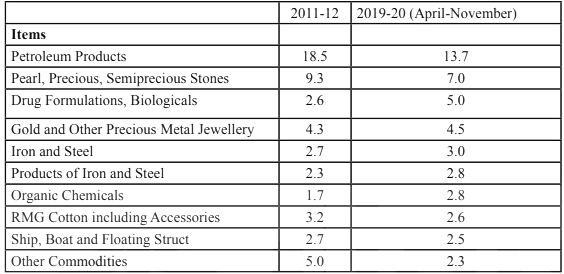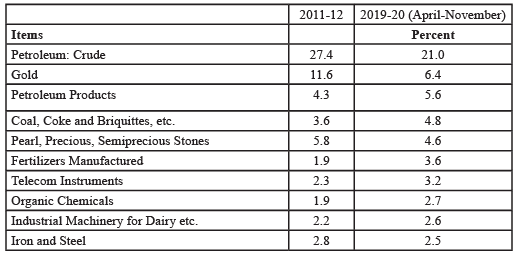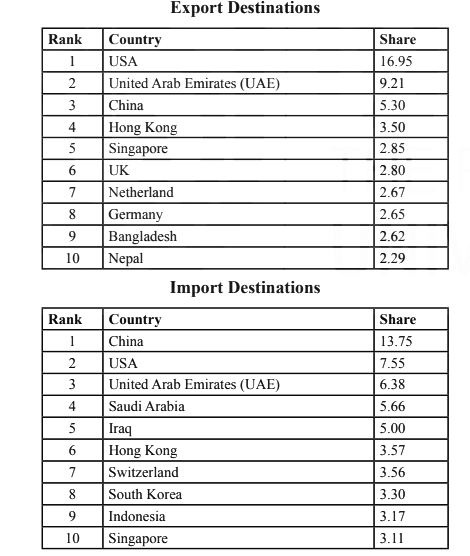Changing Composition of Trade in Goods and Services | Management Optional Notes for UPSC PDF Download
| Table of contents |

|
| Trends In India’s Foreign Trade |

|
| Composition Of Foreign Trade |

|
| Trade In Services |

|
| Direction Of India’s Foreign Trade |

|
Trends In India’s Foreign Trade
- In 2019-20, India's trade (exports and imports) accounted for 43.3% of the country's GDP. This was a significant increase from the 15-20% range observed till the 1980s.
- However, India's share in global exports and imports was relatively low, standing at 1.7% and 2.6% respectively for merchandise, and 3.5% for exports and 3.2% for imports in the services sector as per WTO data from 2018.
Export Growth:
- After 1991, India experienced a substantial growth rate in exports, averaging 14.5% annually for 20 years.
- The first decade of reforms saw a growth rate of 8%, while the second decade marked a strong growth of 21% annually.
- This growth outpaced the world average, contrasting with the pre-reform period when India's growth rates were below global averages.
Export Value Increase:
- The value of India's exports doubled from $23 billion in 1993-94 to $45 billion in 2001-02, taking eight years.
- However, from 2001-02 to 2005-06, the export value more than doubled to $105 billion within four years.
- Between 2002-03 and 2010-11, exports increased almost five times from $54 billion to $250 billion.
- India's share in global exports increased from 0.6% in 1993 to 1.7% in 2018.
Trade as a Percentage of GDP:
- India's total merchandise trade as a percentage of GDP increased from 28.2% in 2004-05 to 43.2% in 2011-12.
- Merchandise exports as a percentage of GDP increased from 11.8% to 16.5% during the same period.
Import Growth:
- From 1991 to 2018, the total value of goods exports increased more than 16 times from $18 billion to over $322.5 billion.
- Goods imports increased almost 22 times from $24 billion to $508 billion during the same period.
Challenges and Recovery:
- India's export growth faced challenges due to weakened external demand, global slowdowns, and trade tensions.
- The COVID-19 pandemic significantly impacted trade but a sharp recovery is currently underway.
Composition Of Foreign Trade
Composition of Exports
Transformation of India's Foreign Trade:
- Over the past seventy years, India's foreign trade has changed significantly in terms of the goods traded.
- Manufacturing plays a crucial role in India's export growth, with sectors like engineering, gems and jewelry, petroleum, and textiles contributing about three-quarters of India’s exports.
- India's merchandise trade surged from US$ 95.1 billion in 2000-01 to US$ 793.8 billion in 2011-12, increasing its global export and import share. It ranked 19th in exports and 10th in imports in 2018.
Composition of Exports and Imports:
- In 2019-20, India's total exports (merchandise and services) were US$ 528.45 billion, while imports stood at US$ 598.61 billion.
- Merchandise exports were US$ 314.31 billion, with imports reaching US$ 467.19 billion in the same period.
- Services exports and imports were estimated at US$ 214.14 billion and US$ 131.41 billion respectively.
Major Changes in Export Composition:
- Capital-intensive products' share in exports more than doubled, with groups like transport equipment and machinery registering higher growth compared to traditional sectors like textiles.
- Petroleum products' share in India's exports increased significantly from about 2% in 1993 to 13.7% in 2019, driven by private sector oil refineries.
- There's been a consistent shift towards human capital and technology-intensive products, with a decline in natural resource and unskilled labor-intensive products.
- Growth in 'mineral products' was fueled by 'mineral fuels and oils', while 'organic chemicals' and 'pharmaceutical products' drove the growth of 'chemical products'.
Export Basket Dynamics:
- India's export basket includes 68 dynamic products, with 50 belonging to the capital-intensive category and 18 to the traditional category.
- The combined share of these 68 products in India's total exports has increased rapidly, with the capital-intensive category contributing about 56% of India's total exports.
Summary of Changes:
- India's export basket has shifted away from primary products, with a decline in traditional items like textiles and leather, and an increase in engineering goods and chemical products.
- The composition of India's trade is now dominated by manufactured goods and services.
- Diversification in export products has risen following reforms, leading to a broad-based composition of India’s exports and decreased dependency on any one product category.
Composition of Imports
Shift in India's Import Trade:
- India's import trade has shifted from primary products to capital goods and other intermediate manufactures.
- Notable increases in the import of primary fertilizers, iron and steel, non-ferrous metals, and industrial inputs have been observed.
Reasons for Changes:
- The changes in import composition are driven by the consumption and investment needs of India's growing economy.
- A significant change is the rise in the share of imports of capital goods, reflecting the strong growth of the manufacturing and services sectors.
Imported Product Categories:
- The import bill for telecommunications, equipment, office machines, and aircraft has increased noticeably.
- Fuel imports remain a major item in India's imports.
- Other imported product categories include electronic goods, gold and silver, chemicals, pearls, precious and semi-precious stones, iron and steel, non-ferrous metals, professional instruments, optical goods, etc., and computer software.
Dependency on Edible Oils:
- Due to a greater increase in the demand for edible oils compared to production, India continues to depend on importing edible oils.
Changes in Capital Goods Import Share:
- As India has increased its domestic production capacity for manufacturing capital goods, the import share of capital goods has declined.
Commodity-wise Composition of Exports (Share in Total Exports Percent)

Commodity-wise Composition of Imports in (Share in Total Imports Percent)

Main Items of Exports and Imports of India
Changes in India's Trade Since Liberalization:
- India's trade landscape has diversified significantly since liberalization, with both exports and imports undergoing transformation.
Reasons for Export Composition Changes:
- The shift in India's export composition is a result of rapid growth and diversification within the country's industries.
Imports Composition:
- India's major imports include petroleum products, fertilizers, capital goods, and edible oils. These items have limited flexibility, making it challenging to reduce the overall import bill.
Key Exports of Manufactured Goods:
- India's main exports in the manufactured goods category include gems and jewelry, readymade garments, machinery, drugs and pharmaceuticals, metals, transport equipment, iron and steel, cotton products, electronic goods, dyes, chemicals, leather products, handicrafts, and petroleum products.
Exports of Agricultural and Allied Products:
- India's exports in this category comprise marine products, raw cotton, oil meals, fruits and vegetables, spices, cashew nuts, coffee, tea, unmanufactured tobacco, cereals, and more.
Important Import Items:
- Key imports to India encompass petroleum crude, gold, pearls, precious and semi-precious stones, petroleum products, coal, electronics components, telecom instruments, organic chemicals, industrial machinery (especially for dairy), iron and steel, plastics, medical apparatus, and various other items.
 |
Download the notes
Changing Composition of Trade in Goods and Services
|
Download as PDF |
Trade In Services
India’s services trade has been a major driver of its exports over the past two decades.
India’s trade in services (2014-18) (value in $ billion)

The services sector has not only garnered substantial foreign investment but has also played a significant role in boosting exports and generating extensive employment. Encompassing diverse activities like trade, hotels and restaurants, transport, storage and communication, financing, insurance, real estate, business services, community, social and personal services, as well as services linked to construction, India's services sector has experienced faster growth than the trade in goods. The proportion of services in the overall export trade has been on the rise.
Service Exports as percent of GDP

India's Role as a Global Back-Office:
- India has become known as the world's back-office because many companies from wealthy nations have chosen to outsource their business processes and IT-intensive operations to Indian partners.
- This outsourcing trend has led to a significant increase in India's services trade surplus, especially due to the surge in IT exports.
Diverse Growth in Services:
- India's services sector has experienced notable growth in transport, travel, telecommunications, financial services, construction, legal services, and other areas.
- The software services segment has played a major role in driving the surplus in services trade.
Changes in Services Exports:
- Within the software and IT-enabled services segment, there has been a shift towards newer services like packaged software implementation, systems integration, network infrastructure management, and IT consulting.
- Other growing segments include entertainment (film, music, broadcast, television, live entertainment), education process outsourcing (online education, training, coaching), and the travel and tourism sector.
Increase in Services Imports:
- India's imports of services have risen from $128.36 billion in 2014 to $176.58 billion in 2018.
- Business services constitute about a third of service imports, reflecting the increasing economic activity in the country.
- The component of travel services has been steadily increasing, indicating the growing interest of domestic tourists in global destinations.
Trade Surplus and Fluctuations:
- India has maintained a trade surplus in all major services, although there have been fluctuations in the surplus over the past five years.
India’s imports of services (2014-18)

Direction Of India’s Foreign Trade
Post-Independence Trade Expansion:
- Since independence, India's trade has expanded in various new directions, with significant changes observed in the countries India trades with.
- India has developed trading relations with all major trading blocs and geographical regions worldwide.
Major Trading Partners:
- India's key trading partners include China, USA, UK, Russia, Japan, Germany, France, Iran, Iraq, Belgium, Saudi Arabia, UAE, Hong Kong, and Singapore.
- Trade with emerging markets and developing countries has seen remarkable growth.
Shifts in Regional Trade:
- In Asia, there has been a decline in trade with North East Asia (China, Hong Kong, Japan) and ASEAN countries, while trade with West Asia-GCC (Gulf Cooperation Council) nations has increased notably.
Free Trade Agreements and Negotiations:
- India has recently signed free trade agreements with South Korea and ASEAN, and is negotiating agreements with partners like the EU, MERCOSUR, Australia, New Zealand, and South Africa.
Top Export and Import Destinations:
- India's top five export destinations are USA, UAE, China, Hong Kong, and Singapore.
- The top five countries from which India imports goods are China, USA, United Arab Emirates, Saudi Arabia, and Iraq.
Top ten export and import destinations of India in 2019-20

Changes in Export Composition to Major Trading Partners:
- Significant shifts have occurred in the types of items India exports to major trading partners, particularly the USA and China.
Exports to the USA:
- India's exports to the USA have seen a rise in the share of primary products, but a decline in the share of manufactured goods.
- This decrease is mainly due to slower growth rates in textile and gems and jewelry exports.
Exports to China:
- In exports to China, the share of primary products has decreased due to a fall in the share and growth rate of ores and minerals.
- Manufactured goods' share in India's exports to China has increased, driven by higher shares in engineering goods, textiles, and chemicals.
Exports to the EU:
- India's exports to the European Union (EU) have experienced a slight increase in the share of primary products and petroleum products.
- Conversely, there has been a decrease in the share of manufactured goods in exports to the EU.
Traditional Markets and Emerging Markets
Market Regions Division:
- Market regions can be broadly categorized into two groups:
- Traditional markets: Australia, New Zealand, Europe, Japan, and North America.
- Emerging markets: South and Central America, the Caribbean, Asia, and Africa.
- Market regions can be broadly categorized into two groups:
Changes in Export Markets:
- The share of traditional markets in India's exports has been steadily decreasing over time.
- Emerging markets now make up nearly two-thirds of India’s exports.
- India's export shares to most countries in the emerging markets group have increased, notably to the UAE and China.
Focus on New Markets:
- Since 2009, India has been focusing on its Look-East policy and exploring new markets like Latin America, Africa, and Oceania.
- Export growth has remained steady, despite declining demand from traditional markets like the US and the EU.
- China remains India's largest exporter, followed by the USA, UAE, and Saudi Arabia.
Need for Market Diversification:
- There is a growing need to diversify India's export markets to reduce dependency on specific countries and regions.
FAQs on Changing Composition of Trade in Goods and Services - Management Optional Notes for UPSC
| 1. What are the trends in India's foreign trade? |  |
| 2. How is the composition of India's foreign trade changing? |  |
| 3. What is the direction of India's foreign trade? |  |
| 4. What is the significance of trade in services for India's foreign trade? |  |
| 5. How is the composition of trade in goods and services changing in India? |  |





















